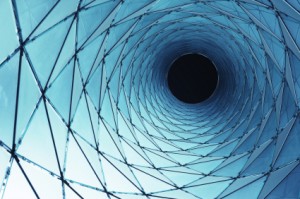Can a 3D printed object be responsive to its environment and to the dynamic energies of the people and processes that interact with it? The idea: given the right conditions and variables, one could see the shape of the magnetic field created around an object. I will attempt to create this by placing a metal 3D printed object in a glass sphere with magnets on the top and bottom and filling the sphere with water and ferrofluid. My theory is that the ferrofluid, a mixture of dispersed nano-scale magnetic particles (laserjet toner) and a viscous solution (100% vegetable oil) (HouseholdHacker), would follow the magnetic force applied to the 3D printed object by the magnets and float around the sphere through the water on the flux lines of the magnetic field. The result would be a sort of magnetic snow globe.
My overarching question for this class is how can 3D printing and making play into my desire to create spaces that inspire people to be alive? Could I create a 3D printed object that is alive, responsive, intuitive, and vulnerable and inspires the people who come into contact with it? And how would that object, or the process that unfolds during my attempts to make it, answer the question what does it mean to be human?
Although, not a physicist myself, I realize my project is all about physics, so I was not surprised to find that 3D printing was being used in other physics applications around the world. In the article “Not Immaterial” published in Mechanical Engineering, Physicist Tim Evans of Imperial College in London, was inspired to use 3D printing when he saw a 3D printed object in a museum (Thilmany). “The object was a table inspired by the tree-like structures found in nature, which is an example of a branching process that is commonly encountered in complex systems in theoretical physics.” Evans states, “This led me to think, what other processes familiar to physics could be turned into a 3D printed object?”
University of Chicago physicists Dustin Kleckner and William Irvine answer Evans question in another article by Andrew Grant published in Science News. Kleckner and Irvine are using 3D printing to explore further the “evidence that knotted vortex loops could emerge in and affect the flow of various fluids and plasmas.” Their problem was first, duplicating a knotted vortex in the lab, and second, creating an environment that could hold the vortex long enough for them to study it. Their second problem was solved when they saw a YouTube video of a dolphin making and pushing a vortex ring in the water. Their first problem was solved by 3D printing. They now have a collection of various sized and shaped 3D knotted “wings,” a collection which would be much more limited with traditional manufacturing practices, which they use to recreate knotted vortexes.
I was also interested in the non-scientific realm of the various components of my project. I discovered others that have found exciting the beautiful displays made with magnets and ferrofluid. Krunal Patel, founder of Fluux Design Lab, LLC in Houston has launched a Kickstarter campaign to “explore and bridge the gap between material science and artistic expression.” His project? A free standing magnetic tube filled with water and ferrofluid which observers can manually manipulate with an external magnet.
Research into Patel’s educational or professional background did not return any matches, but that did not seem to prevent his backers from pledging over 500% of the project’s original goal, over $112,000. Patel conducted extensive research on the various materials used to come up with a “design element that was aesthetically pleasing,” and would ideally catch the eyes and interests of his backers whose main concern was color coordinating their shiny new toy with their existing high-tech shiny toys. He also included a detailed timeline for the manufacturing and shipping of his unit, but comments on Kickstarter’s website seem to indicate delays in shipping times with some backers kicking themselves for being suckered. Perhaps Patel’s function did not meet form.
Another Kickstarter campaign, aptly named “Ferrocious,” takes the same concept, yet provides another variable; music. Russel Garehan’s tube is connected to a musical input that allows the viscous fluid to dance. His design, which is not as sleek and refined as Patel’s, has the added feature of being combined with the audio component. Unfortunately, form did not meet function and Garehan’s campaign only generated 300% of his original goal, a mere $15,528 compared to Patel’s sleek design. However, Garehan’s backers have received their units and Garehan responds directly to his backers’ comments on the Kickstarter website, stating “I’m glad to help as much as I can.”
Garehan received a B.S. in Mechanical Engineering from Louisiana State University and has been featured, for this project, as well as other accomplishments, in popular magazines such as Wired, Popular Science, and Business Report. Perhaps not surprising, Garehan has his own experience in 3D printing as a freelance 3D modeler. Currently, he is a design engineer for Mezzo Technologies in Baton Rouge, Louisiana.
All my research has only further fed my own curiosity for not only how I can use 3D printing to bridge the gap between my linear left brain and creative right brain, but also whether what I aim to achieve is even possible. Although, my question remains the same, one other study I found gave me an alternative path to follow should my original design not produce the intended result.
Akiva J. Dickstein and colleagues experimented with the theory that “ferrofluids are known to produce complex labyrinthine patterns when trapped between closely spaced glass plates and subjected to a magnetic field normal to the plates.” Although they led their research with the inquiry of how the patterns form, my response was to create a design that would capture the pattern as another version of the magnetic snow globe with a complex labyrinth for the ferrofluid to navigate during its magnetic journey.
The Kickstarter campaigns, which combined the awe and respect of an academically acclaimed scientific system with the beauty and creativity of artistic expression, both received well over the minimum pledges, demonstrating that people are indeed curious and excited about new devices and technology that allow them to explore complex scientific systems within their own human experience. Whether this curiosity is driven by a consumer need for instant gratification and social inclusion or a human need to observe, participate and understand the world in which we live remains under the umbrella of the inquiry what does it mean to be human?However, all my research pointed in the direction that, yes, a 3D printed object can in fact be responsive to its environment and to the dynamic energies of the people and processes that interact with it, and this responsive ability may very well occupy a large sector of future 3D printed technologies.
Works Cited



